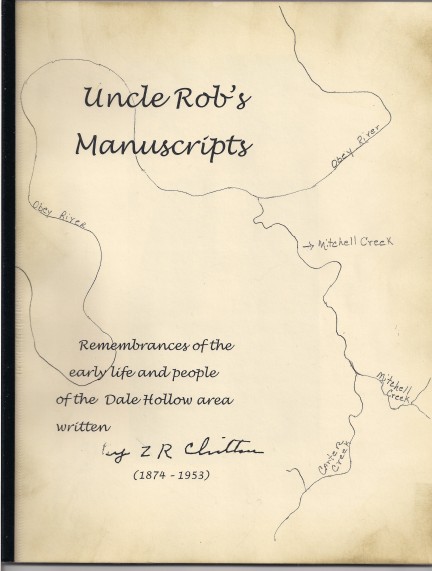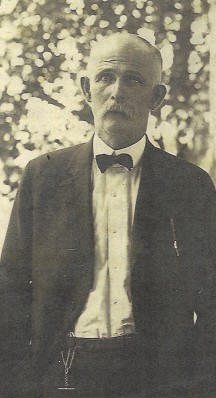
I recently obtained a copy of "Uncle Rob’s Manuscripts" complied by Faye Qualls, a great-niece of Zachariah Robert Chilton, whose collection of writings was among the personal possessions of Faye’s mother, Mrs. Ruth West Qualls. Mr. Chilton’s writings tell about how life was on Mitchell Creek and Carter’s Creek and the families who lived there many years before the construction of Dale Hollow dam. With Faye’s permission, I am including some paragraphs taken from Chapter Two of the manuscript. It begins as follows:
"In 1884, when we crossed Obed’s River on a wagon drawn by four horses, with "Whistlin" Dick Johnson as driver, my father, mother, and six of the ten children were along. Billy, the oldest, riding the family nag, Anne, Jennie, Jim, Tom, and myself were seated in the rear of the wagon bed, watching the family cow, "Old Heif," that was roped and tied to the back end of the wagon with her last off spring that we called "Roanie." Roanie the calf had to swim through the deepest part; this, of course, excited us children, especially Tom, the baby. As we pulled out of the river and up the bank, we paused to rest for a few minutes, so the calf could "jerk it down" a little nourishment in order to give it strength to make the rest of the journey eight miles up the creek and on the hill. Mother also at this time tended to Tom, the baby.
"We began to view the rich fertile fields, the first farm belonging to John Riley who had settled there before the Civil War, and had taken part in the Confederate Army. His wife, Rachell, his son, the noted Bob Riley, and his two daughters, Ruth and Price, also his grandson, Dudley Hunter, constituted the household.
"Beyond the barn, at the head of the hollow, lived the only colored family on the creek known as "Nigger Mitch," one of the old time slaves and a truly black "Mammy" of the South. Nigger Mitch was loved and highly respected by everyone who knew her.
"On the other side of the creek on top of the highest bluff in Clay County was the only dry goods store and post office on the two creeks. This store and post office was owned and operated by Joe Chatt Chowning, the youngest man from Clay County to serve in the Confederate Army. Two hundred yards from this store lived "Cussin" Bill Brown. He derived his title during the Civil War when he served under General Forrest, and it was known he went in and out of battles cursing. His wife, Annie, Mary and Butler Kirkpatrick and John Butler comprised this family at that time. A short distance from Bill Brown’s place and across the road lived Dave Bullock, his wife, Liz, a daughter Flaura Bell, and two sons, Jim and John. Passing by these homes and on up the creek three-fourths of a mile, we came to a landmark, "New Salem Methodist Church." Close by this lived Lafayette Chilton who served in the Confederate Army. Here he, his wife, Jennie, and two children, John and Mary, lived. He was familiarly known up and down the creek as Uncle Fate. Soon after Reconstruction days set in, he was prizing tobacco, a beam fell on him, breaking his back, causing him to be an invalid for twenty-seven years, being paralyzed from his hips down. He remained in bed all this time. However, his ingenious wife, Jennie, fastened a strong leather strap to the ceiling directly over his bed which enabled him to turn and raise himself up in bed. Uncle Fate continued to work with his hands, knitting, sewing, carding thread, patching, piecing quilts, making baskets, tying brooms, reading, writing, embroidering; in fact, anything that was to be done with his hands. He was also a great entertainer and people from up and down the creek would load him in the wagon on a cot, sometimes lifting him in a sheet (as he only weighed 60 pounds), take him to their homes for a visit. He would occasionally go to the "Confederate Reunions" many miles away. Sometimes friends, neighbors and relatives would carry him on his cot supported by ropes to a nearby funeral.
"Coming further up the creek, watching the crystal clear water roll over the rocks, not realizing at that time that a certain percent of this water was coming from under the highest peak known as Pond Ridge, and that our family would use this water for over a half century, we soon arrived at the old homestead of Billy Davis, one of the pioneer settlers who had come from Missouri, settling here before the elks and deer had left the creek; living at this place was Hamilton Brown who had married two of Davis’ daughters. The second wife, Mack, and two daughters, Cora and Suzannie, four boys, William Thomas, by the first wife, James, Joe, and John by Mack.
"Further on, at the head of this farm resided T.V. Davis, known as Little Tom who served in the Confederate Army in Company B, 8th Tenn. Infantry, as a messmate of W. H. Chilton, and carried Chilton off of the battlefield when he was wounded at Franklin. With Little Tom lived his life, Leona, and his eighty year old mother, Aunt Sally, as she was familiarly called. In the hollow above lived Lark Ray and his wife, Dora Chilton Ray, and two sons, Floyd and Willard, and one daughter Minnie. Further around the bend of the creek we came to the home of Burris Jacob Martin who was a brother of Ruthie Martin, one of the older settlers. With Mr. Martin lived his wife, Liza, and his twin daughters, Ollie and Eunice, a younger daughter, Betty, and his son, Joe Wheeler. Mr. Martin was a Mexican soldier, and the only one living on the creek who drew a Mexican pension.
"Still further up the creek one-half mile lived Millie Nivins, with a feeble brother Cook Johnson. They had come from Missouri settling here soon after the Civil War. Cook was noted for building rock fences up and down the creek. Millie had three sons, Jim, Ike, and Gent, and one daughter, Melia. One-Fourth mile above at the mouth of Carter’s Creek where it emptied into Mitchell’s Creek lived Old Tommy Davis, and his wife, Susanna. A beautiful, rich fertile field lay between the creek and his house where Davis plowed a cow during the Civil War after the Union men had driven off all the mules, horses, and oxen to Kentucky for the benefit of the Union Army.
"Still further up the creek we came to the home place of William Wesley Chilton, my grandfather, who had settled there from Adair County, Kentucky fifteen years before the Civil War, or sometime in 1846. He died in 1881. His widow lived here with her grandson, Andy Chilton. Just below the house on the bank of Carter’s Creek lived her only son, "Bud," whose real name was Almaran Powhatan Pahatten, nicknamed to "Ingern" (Onion) head, because his hair all came out. His wife, Sarah, two daughters, Trudy and Sissie, two sons, Ed and Elbert. A little farther from this place where Carter’s Creek forked, lived old Tommy Martin and his wife, Jane, in the only brick house on the creek. Uncle Tommy fell from the barn loft killing himself instantly in 1896.
"Up the west prong of Carter’s Creek lived John Dubree, a Dibrell Scout during the close of the Civil War, his wife, Liz, and children, Wesley, Henry, Sarah, Susie, Carrie, Judith, Phenie, Marcus Lafayette, commonly called "Boss," James Nine, being thusly called because he was the ninth child.
"The last house situated on this prong at this time was Billy Martin’s, his wife, Liza, daughters, Nannie, Mollie, Eunice, and Mary, two sons, Bob and John, lived with him.
"On the South prong of Carter’s Creek lived Jessie Martin, his wife, Nancy, four daughters, Anne, Sarah, Tiza, and Celina. Farther up this hollow lived Tom Cope, his wife, Katy, two sons, Lije and Kam, two daughters, Lou and Haney. At the extreme end of this hollow lived Marion Owens, his wife, Lockey, two sons, Brance and Everett. This concludes the families living on Carter’s Creek.
William Wesley Chilton, Ole Tommy Martin, Ole Tommy Davis (these were commonly called Old) were the oldest settlers on Carter’s Creek. It was their contention when they moved to the creek that a man named Polly Carter had settled in the extreme head of Carter’s Creek on the South Prong, up in the woods on the hillside. They believed Carter to be 100 years old or more. He had one son, Zeb Carter. Polly Carter contended that he fed from North Carolina during the uprising of the Tories, and his son, Zeb, was born somewhere on the way to Tennessee during this flight. His reason for settling in the head of a hollow was that he depended on his gun for his living. The woods were rich in nuts of all kinds, and filled with fine rich game. The turkey breast was used for bread and bear for meat. The Carters made one trip every year to Louisville, Kentucky for their supply of ammunition; and to make this cross country trip it required six weeks. They traveled on foot, following deer paths through cane breaks that followed the rivers and creeks. On one of these return trips he found his patch of corn that faced the Chilton homestead had been eaten by the elks. He and his wife Cynthia went carefully over the corn patch, searching for remaining fragments of corn that the elks might have left, and all that remained was something near a bushel. They shelled this, and carried it to Marrow Bone, Kentucky, to a horse mill and had it ground into meal. The distance to the mill was 75 miles or more and required three weeks to make the trip. On the way back to Carter’s Creek, they made bread from their new ground meal, using water from Carter’s Creek, and baked it on rocks, heated with brush and sticks. Uncle Polly let "Sindy", his wife, eat this bread, since she was "suckling" Zeb the baby."
This is only a portion of the writings contained in the manuscript. Copies can be obtained at the museum or by contacting Faye Qualls, 486 Okolona Road, Rickman, TN 38580; telephone number 931/498-2764; or email address at fqualls@twlakes.net.
